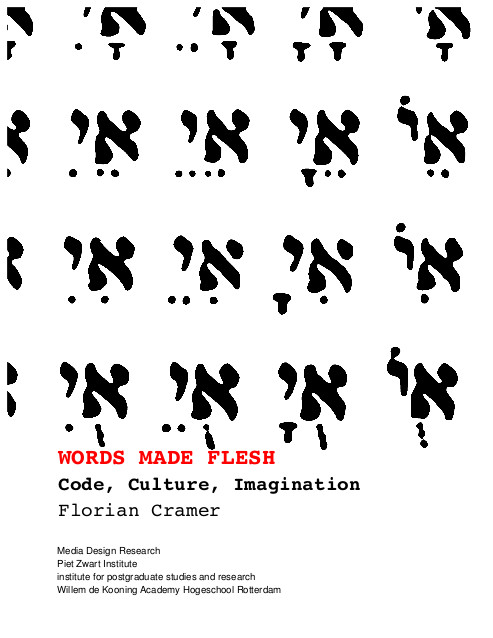Craig J. Saper: Networked Art (2001)
Filed under book | Tags: · art, bureaucracy, conceptual art, concrete poetry, fluxus, lettrism, mail art, network culture, networks, poetry, visual poetry

“Outlines an exciting new approach to this confluence of art, media, and poetry.
The experimental art and poetry of the last half of the twentieth century offers a glimpse of the emerging networked culture that electronic devices will make omnipresent. Craig J. Saper demarcates this new genre of networked art, which uses the trappings of bureaucratic systems—money, logos, corporate names, stamps—to create intimate situations among the participants.
In Saper’s analysis, the pleasures that these aesthetic situations afford include shared special knowledge or new language among small groups of participants. Functioning as artworks in themselves, these temporary institutional structures—etworks, publications, and collective works—give rise to a gift-exchange community as an alternative economy and social system. Saper explains how this genre developed from post-World War II conceptual art, including periodicals as artworks in themselves; lettrist, concrete, and process poetry; Bauhaus versus COBRA; Fluxus publications, kits, and machines; mail art and on-sendings. The encyclopedic scope of the book includes discussions of artists from J. Beuys to J. S. G. Boggs, and Bauhaus’s Max Bill to Anna Freud Banana. Networked Art is an essential guide to the digital artists and networks of the emerging future.”
Key words and phrases: Fluxus, concrete poetry, mail art, mail artists, visual poetry, Dick Higgins, Big Dada, conceptual art, Ray Johnson, George Maciunas, sound poetry, Ken Friedman, Guy Bleus, Bauhaus, detournement, neoist, Max Bill, Augusto de Campos, George Brecht, Joseph Beuys
Publisher University of Minnesota Press, 2001
ISBN 0816637075, 9780816637072
198 pages
PDF, PDF (updated on 2018-9-21)
Comments (3)Florian Cramer: Words Made Flesh: Code, Culture, Imagination (2005)
Filed under book | Tags: · art, art history, code, code poetry, computation, experimental literature, kabbalah, language, literature, philosophy, poetry, religion, software, software art, technology

“Executable code existed centuries before the invention of the computer in magic, Kabbalah, musical composition and experimental poetry. These practices are often neglected as a historical pretext of contemporary software culture and electronic arts. Above all, they link computations to a vast speculative imagination that encompasses art, language, technology, philosophy and religion. These speculations in turn inscribe themselves into the technology. Since even the most simple formalism requires symbols with which it can be expressed, and symbols have cultural connotations, any code is loaded with meaning. This booklet writes a small cultural history of imaginative computation, reconstructing both the obsessive persistence and contradictory mutations of the phantasm that symbols turn physical, and words are made flesh.”
Editor: Matthew Fuller, additional corrections: T. Peal
Published within Media Design Research programme, Piet Zwart Institute, Willem de Kooning Academy Hogeschool, Rotterdam
GNU General Public License 2; GNU Free Documentation License 1.2; Creative Commons Attribution-ShareAlike License 2.0
141 pages
Review: Tomáš Javůrek (Joinme, 2018, CZ).
PDF (updated on 2012-10-11)
HTML (added on 2013-7-1)
Sequel: Exe.cut(up)able statements: Poetische Kalküle und Phantasmen des selbstausführenden Texts (2011, in German).
Comment (0)Adalaide Morris, Thomas Swiss (eds.): New Media Poetics: Contexts, Technotexts, and Theories (2006)
Filed under book | Tags: · code poetry, concrete poetry, digital poetry, electronic literature, literature, new media, poetics, poetry, sound poetry, text

New media poetry–poetry composed, disseminated, and read on computers–exists in various configurations, from electronic documents that can be navigated and/or rearranged by their “users” to kinetic, visual, and sound materials through online journals and archives like UbuWeb, PennSound, and the Electronic Poetry Center. Unlike mainstream print poetry, which assumes a bounded, coherent, and self-conscious speaker, new media poetry assumes a synergy between human beings and intelligent machines. The essays and artist statements in this volume explore this synergy’s continuities and breaks with past poetic practices, and its profound implications for the future.
By adding new media poetry to the study of hypertext narrative, interactive fiction, computer games, and other digital art forms, “New Media Poetics” extends our understanding of the computer as an expressive medium, showcases works that are visually arresting, aurally charged, and dynamic, and traces the lineage of new media poetry through print and sound poetics, procedural writing, gestural abstraction and conceptual art, and activist communities formed by emergent poetics.
Contributors: Giselle Beiguelman, John Cayley, Alan Filreis, Loss Pequeno Glazier, Alan Golding, Kenneth Goldsmith, N. Katherine Hayles, Cynthia Lawson, Jennifer Ley, Talan Memmott, Adalaide Morris, Carrie Noland, Marjorie Perloff, William Poundstone, Martin Spinelli, Stephanie Strickland, Brian Kim Stefans, Barrett Watten, Darren Wershler-Henry
Published by MIT Press, 2006
Leonardo Books
ISBN 0262134632, 9780262134637
425 pages
PDF (updated on 2012-7-24)
Comment (0)
